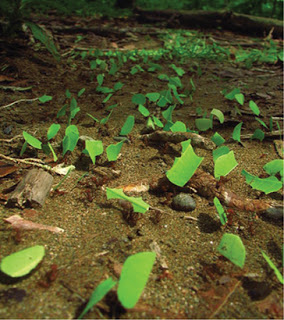
Leaf-cutter ants forage for leaves that they use to cultivate a fungus in specialized gardens.
(Wikipedia, CC-BY-SA-3.0,2.5,2.0,1.0)
Leaf-cutter ant colonies are comprised of millions of ants harvesting hundreds of kilos of leaves annually for use in growing their primary food source, a fungus. The fungal gardens tended by these ants allow them to convert plant biomass on a very large scale. Bioenergy researchers are looking at the microbial composition of the fungal gardens to learn more about the process by which the leaves are decomposed and the cellulose is degraded.
Though the ant farmers have been studied since the 19th century, more recent studies have focused on the microbial community in the fungal gardens. The findings indicate that the fungal gardens contain Enterobacteriaceae and Pseudomonas bacteria. Members of these bacteria are known to play roles in fermenting sugars and help digest food in gut microbiomes.
In a report published online February 21, 2013 in Genome Announcements, researchers from the DOE Joint Genome Institute and longtime collaborators led by Cameron Currie at the Great Lakes Bioenergy Research Center isolated and sequenced a strain of Enterobacteriaceae bacterium from a fungal garden in Panama. The sequence followed metaproteomic studies of the proteins found in fungal gardens indicated the presence of several strain Enterobacteriaceae FGI 57 proteins, suggesting that this bacteria plays a role in the fungal gardens. The bacterium’s complete genome, wrote the researchers, “will facilitate future investigations of the symbiotic microbial community residing in leaf-cutter ant fungus gardens.”